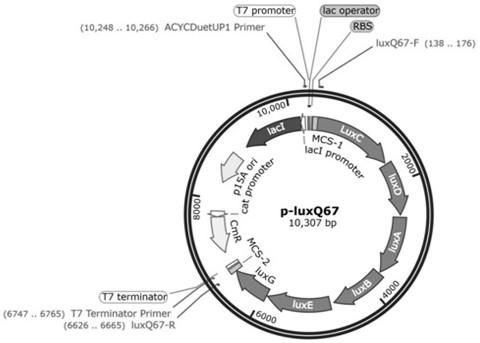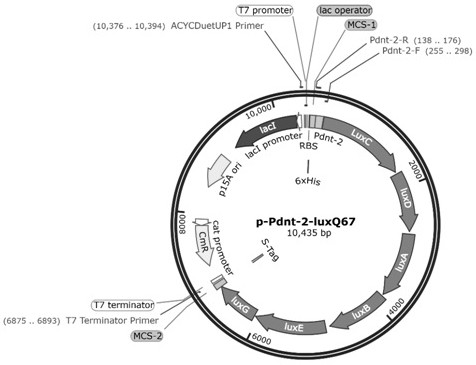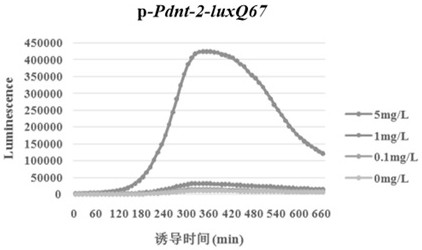Novel MR-1 gel bead for detecting explosive molecules as well as preparation method and application of novel MR-1 gel bead
An MR-1, explosive technology, applied in the fields of genetic engineering and molecular biology, can solve problems such as difficulties, high activity of sensor strains cannot be guaranteed, and real-time detection of explosives increases.
- Summary
- Abstract
- Description
- Claims
- Application Information
AI Technical Summary
Problems solved by technology
Method used
Image
Examples
Embodiment 1
[0035] Embodiment 1: the acquisition of gene and the construction of vector
[0036] 1. Acquisition of genes
[0037] One from Qinghai Vibrio Q67 ( Vibrio qinghaiensis Q67) luxABCDE operon, the nucleotide sequence of which is shown in SEQ ID NO.1, was chemically synthesized by BGI Corporation into pUC-57 vector to obtain pUC-luxQ67 vector.
[0038] The Pdnt-2 promoter gene, whose nucleotide sequence is shown in SEQ ID NO.2, was chemically synthesized by Huada Gene Co., Ltd. into the pUC-57 vector to obtain the pUC-Pdnt-2 vector.
[0039] 2. Construction of p-luxQ67 expression vector
[0040]Using pUC-luxQ67 as a template, primer luxQ67-F and primer luxQ67-R, perform polymerase chain reaction (PCR) to amplify the luxQ67 fragment. The PCR amplification system is as follows:
[0041]
[0042] The PCR program was: 95ºC 3 min; 30 cycles × (95ºC 15 s, 58ºC 15 s, 72ºC 4 min); 72ºC 5min; 16ºC ∞.
[0043] The primer sequences are as follows:
[0044] luxQ67-F:
[0045] 5'-...
Embodiment 2
[0071] Embodiment 2: the construction of biosensor
[0072] Transform the p-Pdnt-2-LuxQ67 recombinant plasmid Escherichia coli BW25113 competent cells (purchased from Weidi Biotechnology, product number DL2050), were spread on LB solid plates containing 34 mg / L chloramphenicol, and positive clones were obtained by PCR screening, thereby obtaining vector p-Pdnt-2-luxQ67 The engineering strain MR-1.
Embodiment 3
[0073] Embodiment 3: The preparation of the novel condensed beads of detection engineering strain MR-1
[0074] 1. Activation and cultivation of strains
[0075] The engineered strain MR-1 with correct sequencing was inoculated into 10 mL LB medium supplemented with 10 µL of Kanna, cultured overnight at 37 °C with shaking (200 rpm), and then the culture was transferred to a new 10 mL LB medium at 2%. medium and grown under the same conditions to an optical density of 600 nm (OD 600 ) is 0.8.
[0076] 2. Preparation of related solutions for immobilized bacteria
[0077] (1) Preparation of 2.2 % (w / v) sodium alginate solution: Weigh 1.1 g of sodium alginate solid, dissolve it in deionized water to 50 mL, stir the solution until all the sodium alginate is dissolved, and then Add agar powder to the mixed sodium alginate at 1.1%, and sterilize by high pressure steam.
[0078] (2) 9% polyacrylic acid (PAA) solution (35% polyacrylic acid, molecular weight 250000): Take 9 mL of 35...
PUM
 Login to View More
Login to View More Abstract
Description
Claims
Application Information
 Login to View More
Login to View More - R&D Engineer
- R&D Manager
- IP Professional
- Industry Leading Data Capabilities
- Powerful AI technology
- Patent DNA Extraction
Browse by: Latest US Patents, China's latest patents, Technical Efficacy Thesaurus, Application Domain, Technology Topic, Popular Technical Reports.
© 2024 PatSnap. All rights reserved.Legal|Privacy policy|Modern Slavery Act Transparency Statement|Sitemap|About US| Contact US: help@patsnap.com










